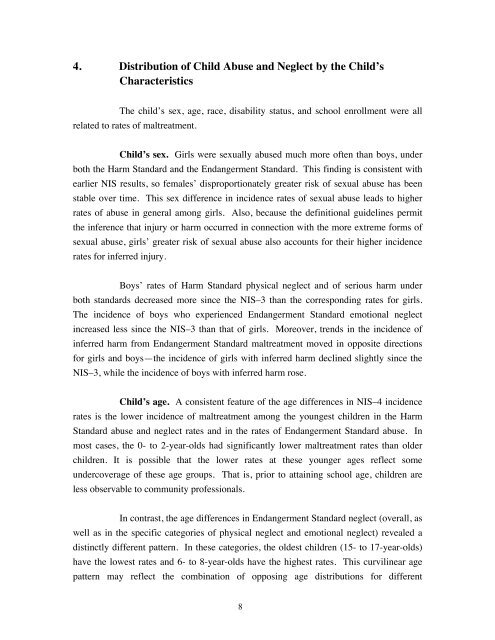National Incidence Study of Child Abuse and ... - Children's Central
National Incidence Study of Child Abuse and ... - Children's Central
National Incidence Study of Child Abuse and ... - Children's Central
- No tags were found...
Create successful ePaper yourself
Turn your PDF publications into a flip-book with our unique Google optimized e-Paper software.
4. Distribution <strong>of</strong> <strong>Child</strong> <strong>Abuse</strong> <strong>and</strong> Neglect by the <strong>Child</strong>’sCharacteristicsThe child’s sex, age, race, disability status, <strong>and</strong> school enrollment were allrelated to rates <strong>of</strong> maltreatment.<strong>Child</strong>’s sex. Girls were sexually abused much more <strong>of</strong>ten than boys, underboth the Harm St<strong>and</strong>ard <strong>and</strong> the Endangerment St<strong>and</strong>ard. This finding is consistent withearlier NIS results, so females’ disproportionately greater risk <strong>of</strong> sexual abuse has beenstable over time. This sex difference in incidence rates <strong>of</strong> sexual abuse leads to higherrates <strong>of</strong> abuse in general among girls. Also, because the definitional guidelines permitthe inference that injury or harm occurred in connection with the more extreme forms <strong>of</strong>sexual abuse, girls’ greater risk <strong>of</strong> sexual abuse also accounts for their higher incidencerates for inferred injury.Boys’ rates <strong>of</strong> Harm St<strong>and</strong>ard physical neglect <strong>and</strong> <strong>of</strong> serious harm underboth st<strong>and</strong>ards decreased more since the NIS–3 than the corresponding rates for girls.The incidence <strong>of</strong> boys who experienced Endangerment St<strong>and</strong>ard emotional neglectincreased less since the NIS–3 than that <strong>of</strong> girls. Moreover, trends in the incidence <strong>of</strong>inferred harm from Endangerment St<strong>and</strong>ard maltreatment moved in opposite directionsfor girls <strong>and</strong> boys—the incidence <strong>of</strong> girls with inferred harm declined slightly since theNIS–3, while the incidence <strong>of</strong> boys with inferred harm rose.<strong>Child</strong>’s age. A consistent feature <strong>of</strong> the age differences in NIS–4 incidencerates is the lower incidence <strong>of</strong> maltreatment among the youngest children in the HarmSt<strong>and</strong>ard abuse <strong>and</strong> neglect rates <strong>and</strong> in the rates <strong>of</strong> Endangerment St<strong>and</strong>ard abuse. Inmost cases, the 0- to 2-year-olds had significantly lower maltreatment rates than olderchildren. It is possible that the lower rates at these younger ages reflect someundercoverage <strong>of</strong> these age groups. That is, prior to attaining school age, children areless observable to community pr<strong>of</strong>essionals.In contrast, the age differences in Endangerment St<strong>and</strong>ard neglect (overall, aswell as in the specific categories <strong>of</strong> physical neglect <strong>and</strong> emotional neglect) revealed adistinctly different pattern. In these categories, the oldest children (15- to 17-year-olds)have the lowest rates <strong>and</strong> 6- to 8-year-olds have the highest rates. This curvilinear agepattern may reflect the combination <strong>of</strong> opposing age distributions for different8
















